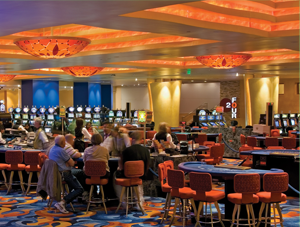The WSOP And Where It Began
The first World Series of Poker was held in 1970, and is a far cry from the international championship it is today. At the time, there were less than 50 poker tables within Las Vegas, and only 70 in the whole of Nevada. The championship itself (if you can even call it that) was so small and garnered so little interest, that it was not even held in a poker room. The Horseshoe Casino, which is the site of this prestigious tournaments humble beginnings, did not have a poker room at all. Instead, players were squeezed around tables in an alcove of the casino. Those players were unaware at the time, but they would be making poker history.
The Prequel To The WSOP
Benny Binion is the man who is heralded as the man to dream up the WSOP, but in fact 2 other men deserve a mention in its inception. The year before the first WSOP was held, Tom Moore (the part owner of a casino in Reno) and Vic Vickrey (a gambling insider) joined together and invited several high stakes poker players to join them in Reno for a match which would be known as the Texas Gamblers Reunion. It was after the days of the Mafia and Vegas, but it was also the only instance of the event, and the following year Tom Moore and Vic Vickrey declined to host a poker event, leaving the opportunity for Benny Binion (who attended the Texas Gamblers Reunion the year before) wide open for the taking.
The Beginning of the WSOP
The very first winner of the WSOP was a player called Johnny Moss and his win was as exciting as games of online casino keno are today. The format of the initial competition was such that Johnny did not even win a poker tournament. He was voted as best all-round player by his opponents in the several days of high stakes games. Benny Binion realized that this format would need to be re-designed, if his tournament was to attract the world’s attention, so he adapted his formula the year after, with the WSOP becoming a freeze-out, with players paying a buy in of $5000 each. Johnny Moss won the final prize, and so managed to retain his title as world champion.
The WSOP Goes From Strength to Strength
The WSOP was relatively unknown at first, but in 1972, Thomas “Amarillo Slim” Preston was the champion of the tournament and he used this to launch himself into the spotlight, thus bringing the WSOP with him. Over the next 10 years, he would appear on the Tonight Show 11 times, wrote a best-selling book, and played in various movies. He was an ambassador for the World Series of Poker, and captured the public’s attention for the tournament.
The WSOP Gets Televised
What started with Thomas Preston, continued with Stu Ungar. He erupted onto the scene in 1980, winning the championship. Stu Ungar piqued the public’s interest, because he was so different to what the world had begun to associate with poker players. Stu came from New York, and was the youngest player to ever win the WSOP. This was further compounded by the fact that he looked younger than his real age, this earning him the nickname of Stu “the Kid” Ungar. He went on to win his second WSOP in 1981, and this created so much publicity for the tournament, that in NBC Sports sent a film crew to capture the event. For the first time in history the WSOP could be watched in millions of homes, and brought it into mainstream society.
The WSOP And Satellite Tournaments
Over the next few years the popularity of the WSOP continued to grow, with the tournament increasing to include 11 preliminary events, as well as a Ladies Championship. Benny Binion had at this stage passed most of the day to day running of the tournament to his son Jack, who along with his tournament director Eric Drache, gave the WSOP its next major boost. They realized that for the competition to appeal to a wider audience across the globe, that aspiring poker players would need to be given the opportunity to play against the professionals. The introduction of Satellite tournaments allowed amateur players to compete for seats at the table at the WSOP.
Competition For The WSOP
A slump occurred in the history of the WSOP in the late 1990’s early 2000’s when a split and controversy within the Binion family caused the decline of the Horseshoe Casino. This resulted in several big names boycotting the event, and the birth of a new rival, the World Poker Tour, caused some people to think that the WSOP was on its way out.
Chris Moneymaker And The WSOP
In 2003, everything changed for the WSOP. Chris Moneymaker, a total unknown on the poker scene won the main event after winning his seat at the table on popular satellite tournament website, PokerStars. Most major tournaments have high priced buy ins making the opportunity to play against poker’s elite untouchable for most of the population. PokerStars made, what was previously unattainable a dream within reach for the man on the street, and injected the WSOP with some much-needed energy and excitement that has carried the tournament forward till today.





